What Is Super Hydrophobic Paint?
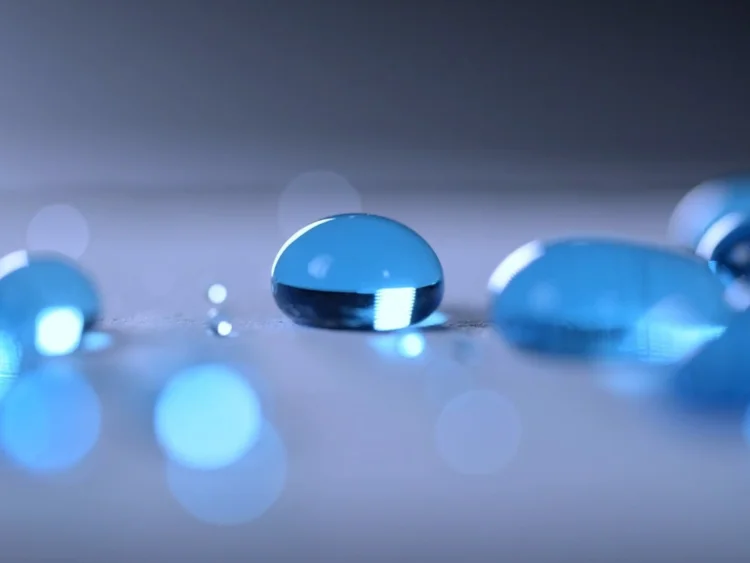
Super hydrophobic technology is revolutionising the paint and coatings industry, but what does super hydrophobic mean, what is a super hydrophobic paint and how can it benefit you? In the guide we are going to answer all of these questions and much more.
What Does Super Hydrophobic Mean?
The term ‘super hydrophobic’ refers to a type of extreme water-repellency that causes water droplets to forms a spherical beads that simply roll off, leaving the surface dry.
You may be wondering where the name super hydrophobic comes from. ‘Hydrophobic’ is commonly known as something that lacks an affinity for water, more specifically either something that is insoluble in water or something that repels water.
The way in which a water droplet interacts with a surface determines whether it is hydrophobic. This is measured by the contact angle between the surface and a drop of liquid. The higher the contact angle the higher the hydrophobicity of a surface. A surface is ‘hydrophilic’ when the water contact angle is less than 90°, ‘hydrophobic’ when the water contact angle is between higher than 90° and ‘super hydrophobic’ when the water contact angle is higher than 150°.
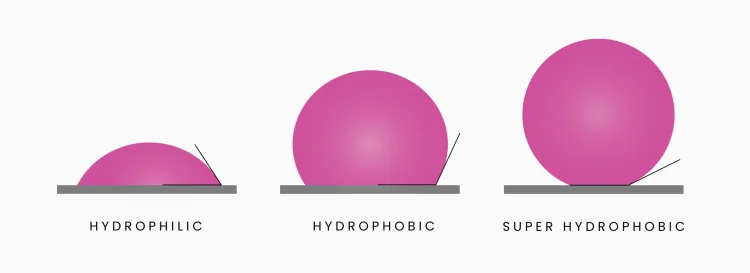
What Is Super Hydrophobic Paint?
Now we have established exactly what a super hydrophobic surface is, let’s discuss what a super hydrophobic paint is. Recognising the power of super hydrophobic technology, we developed our cutting-edge super hydrophobic formulation to create a range of exterior paints and coatings that keep buildings dry.
We achieved this using advanced silicone resin based nano-technology. On a microscopic level, our technology contains millions of tiny pyramids that are naked to the human eye. When the water hits these pyramids, the contact angle is so small that the water cannot attached itself to the surface and simply rolls away. This means that when water is applied to our paints and coatings, it is completely repelled without wetting the surface.
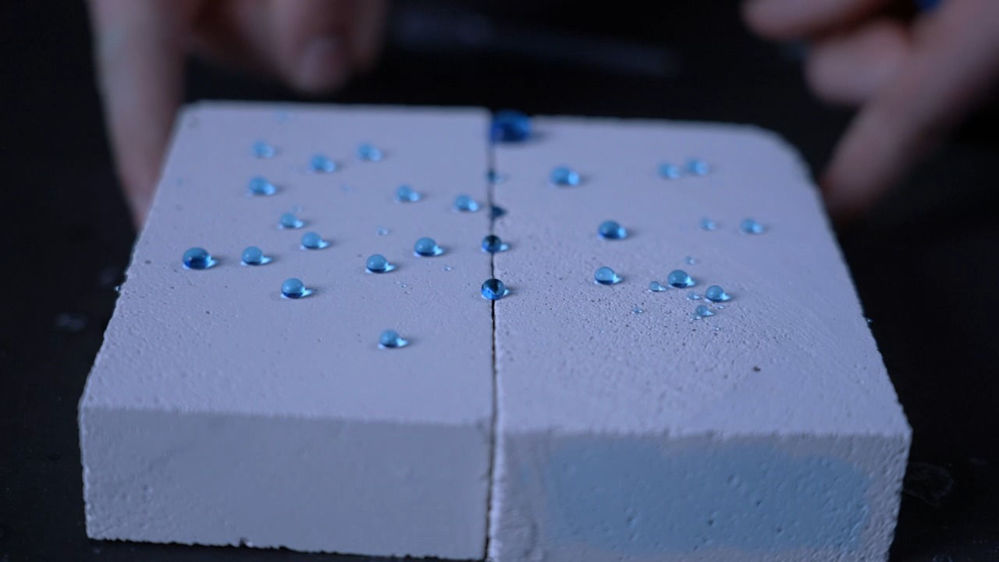
Why Use Super Hydrophobic Paint?
Here in the UK, our homes must endure a lot of poor weather conditions, including rain on average 156.2 days a year according to the UK Met Office. With all of this rainfall, external surfaces must be able to resist moisture for large proportions of the year.
The UK has one of the oldest housing stock in Europe, while poor building practices have also been commonly attributed to the UK housing industry over past decades. This means that our homes are consistently battling the elements and are often underequipped.
Moisture’s natural tendency is to transfer from wet to dry surfaces by the easiest possible means, often aided by gravity. While water can enter a property in any number of ways, houses are designed to limit this and move the moisture away from the structure. Gutters for example collect rainwater from roofs and funnel this moisture back off the building. A damp-proof course is installed at ground level, consisting of fine sheets of material between the brickwork that prevent ground water from soaking up from the ground and up into the external walls of your home. However, the external walls of our homes are still prone to moisture.
Water from wind-driven rain can absorb into the external wall of your home in a process called penetrating damp. While penetrating damp can be caused by leaking gutters and other defects, it is most commonly the process of rainwater absorbing into the external wall and gradually seeping through pores and saturating the surface.
It is a common misconception that external walls are waterproof. While bricks and other masonry surfaces are designed to resist some level of moisture, all bricks are porous and some types of bricks and other exterior surfaces are highly porous.
Not only are bare stone, cement, brick and other natural masonry surfaces able to absorb moisture, these surfaces once painted can still remain prone to penetrating damp. This is because standard masonry paints are not waterproof, meaning while they can reduce absorption compared to bare surfaces, they still absorb moisture over-time. In the case of both bare and painted walls, the more it rains, the more water will transfer into the wall.
The effect that moisture can have on external walls are vast and varied but in short are damp, damage and deterioration.
DAMP
As the name would suggest, the primary impact of penetrating damp is wider damp problems on internal walls. When the moisture enters the external wall it continues to saturate the surface and gradually makes its way through the wall. This transfer of moisture in turn can saturate the internal wall of the property, leading to damp patches, crumbling plaster and peeling wallpaper.
This is most common with solid wall properties as there is no barrier to stop the movement of moisture. As the name would suggest, it is one singular solid wall from exterior to interior. Cavity walls were later developed in order to prevent this transfer by creating a gap between the exterior and interior walls, however the introduction of cavity wall insulation has led to these properties also suffering from internal damp. This is because when the insulation is poorly installed without a gap between the external wall and the insulation itself, moisture can bridge between the two walls and cause damp.
DAMAGE
Damage to external walls is a key indicator and subsequent symptom of water ingress. When water enters an external wall, it can undergo what is known as a ‘freeze-thaw cycle’. This happens when the water freezes as temperatures drop, causing the water to expand. This results in movement within the wall that can lead to a loss of structural integrity. Parts of the brick and mortar can crack and become weak, while spalling can also occur to the brick faces. When this damage starts, it can allow further moisture to enter the wall, which continues the damage cycle. This movement is why cracked render is a common sign of water damage.
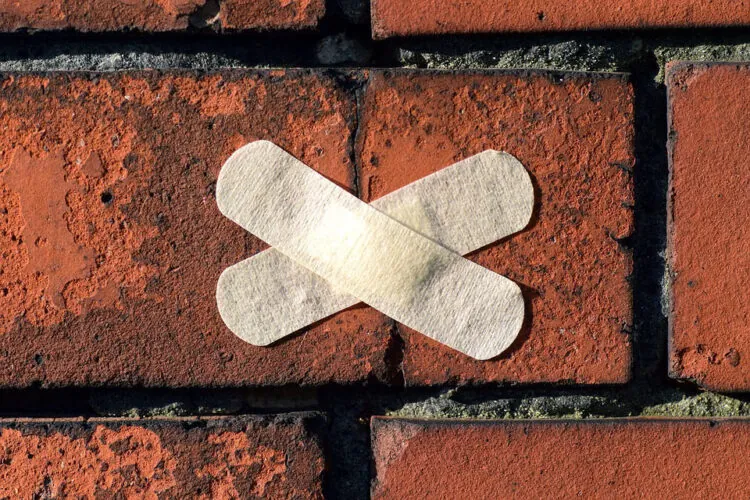
DETERIORATION
The most common and easiest way to spot water absorption on external walls is general wear and tear. This can arise in many forms, for both unpainted and painted walls. These are generally aesthetic but can indicate higher levels of moisture and the potential for more serious problems.
A sight many homeowners across the UK will be familiar with is a white powdery deposit on bare masonry and brickwork. This is called ‘efflorescence‘ and is caused when water-soluble salts are dissolved when they come in contact with moisture. When this water evaporates back out of the surface, these salts travel through the brick’s capillaries and are deposited on the surface. While efflorescence itself is mostly an aesthetic problem, it is a sign of water absorption within a wall.
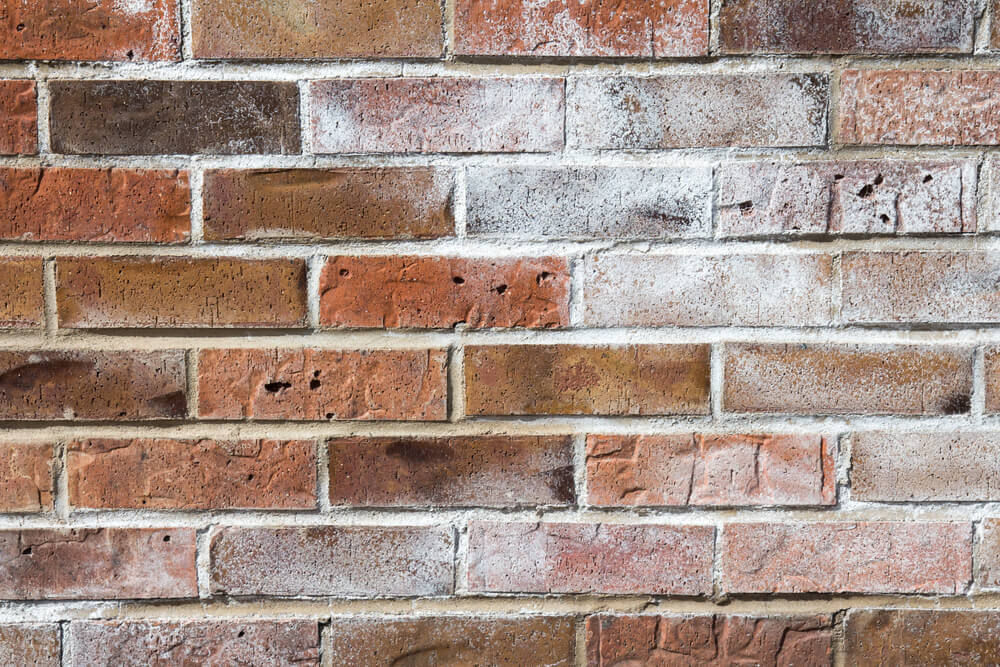
When it comes to aesthetic problems caused by moisture, none is more prevalent than paint failure. While paint failure can be caused by poor preparation, the vast majority of external paint failure is caused by moisture absorbing into the paint film and becoming trapped. As the moisture levels build-up, the moisture begins to lift the paint film from the surface, ultimately causing peeling, flaking and blistering.
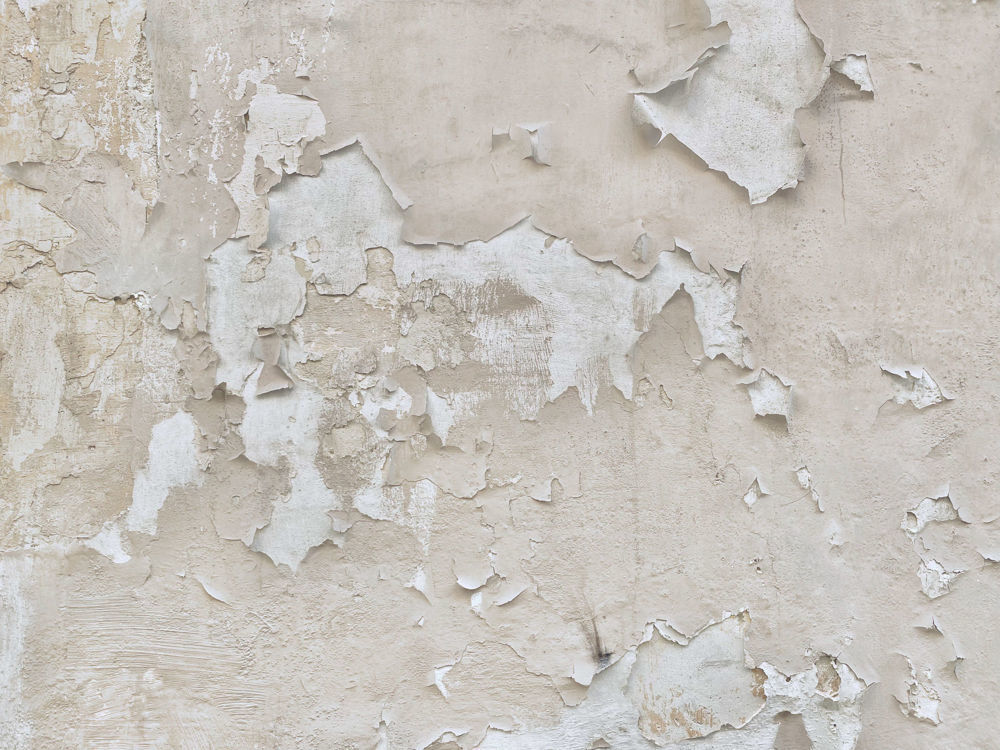
Another key problem caused by moisture within external walls is organic growth. Organic growth is an accumulation of fungal growth on surfaces, including mildew, moss and algae. As with any biological growth, this required water in order to develop, which indicates the wall is holding moisture.
Generally this does not cause structural problems, however brick manufacturer Wienerberger state that ‘organic growths can trap water around the surface of the brick and mortar, and as a consequence can lead to freeze/thaw action (frost damage)’.
Organic growth is more prominent on bare brickwork but can also develop on painted surfaces, particularly in areas where moisture levels are higher, such as where repairs have been made to the surface or in areas that get little sunlight.

All of these problems have water as the route cause. By repelling water and keeping external walls dry, our super hydrophobic paints and coatings help to reduce the risk of these problems that both bare and painted walls suffer from, helping to protect properties from the elements.
Is Super Hydrophobic Paint Breathable?
While keeping moisture out is essential for the performance of a property, allowing moisture from inside to escape is equally important. Our homes create a lot of moisture from the inside from cooking, showers, drying clothes and more. Furthermore, external walls that have been exposed to the weather already will be saturated and therefore have high moisture levels.
Breathability is the ability for air and water vapour to freely travel through a surface. The lower the breathability of the surface, the more impermeable to moisture movement it will be.
If a product is applied to the external walls of a building that has low breathability, this moisture has nowhere to go and will simply build up. Low breathability products can prove disastrous for the health of your home, trapping moisture and in turn making any damp and moisture-related problems worse than if they weren’t applied at all.
Breathability while crucial for any property is even more important for older buildings as these were built using weaker and more porous mortars materials and generally are more prone to damage.
‘Plastic’ paints and sealers are two common terms that are mentioned in relation to breathability. Firstly, plastic paints generally refer to modern, acrylic masonry paints that while have some level of breathability, do not allow high levels of breathability. These paints are the typical masonry paints that you will find in DIY shops across the UK, as these are cheaper and easier to produce. Generally, these masonry paints will last anywhere from 1-10 years before they begin to fail due to long-standing moisture levels.
The term ‘sealer’ refers to clear, invisible products that have been used to waterproof exterior walls by creating a water repellent film on the surface of masonry. The problem with these sealers as the name suggests is that they seal the pores of the substrate, meaning they make the wall impermeable to water vapour movement and therefore have little to no breathability.
This is where Emperor nano-technology comes in. While the super hydrophobic surface that is creating repels water, the more advanced formulation lines the pores of the substrate without sealing these pores. As we discussed, the pyramids on a microscopic level cause water droplets to not be able to stick to the surface, causing it to simply roll off. The gaps between these pyramids however are still large enough that water vapour and air can freely pass through. This open-pore structure means that Emperor super hydrophobic paints are highly breathable.
An SD value is used to measure the ability for a substrate to breathe. The lower the SD value, the higher the breathability of the substrate. A coating is generally considered breathable if it has an SD value of below 0.5. In independent testing, Emperor super hydrophobic products were found to have an SD value below 0.03, which is a breathability level similar to limewash. In contrast, modern plastic paints can often have an SD value in excess of 0.5 and in many cases do not openly disclose the SD value of the paint.
What Products Are Super Hydrophobic?
Super hydrophobic nano-technology has been uniquely formulated using the latest innovation in paint science. We have developed a range of super hydrophobic products for a range of surfaces, helping to keep exterior surfaces dry and protected from the elements.
With both bare and painted surfaces in need of protection from penetrating damp, we developed two cutting-edge super hydrophobic products for masonry that provide different finishes depending on your home.
Emperor Masonry Creme is an invisible treatment for bare surfaces that does not change the appearance of masonry in any way, maintaining its natural beauty. Emperor Masonry Paint is a silicone-based coloured masonry paint that can be applied to any exterior wall, including bare and painted surfaces.
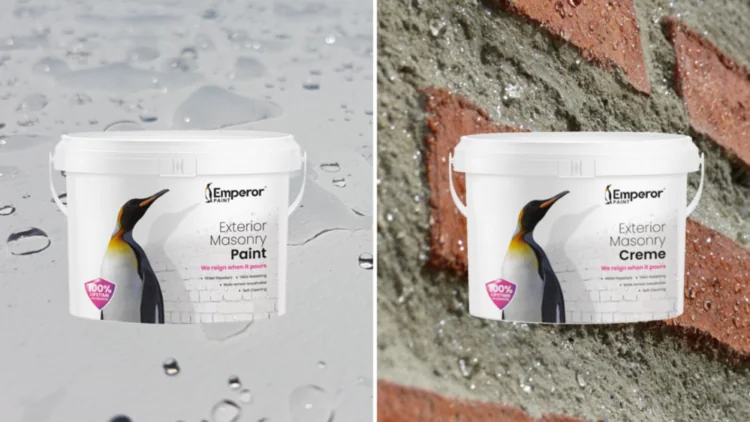
As we have mentioned, moisture is the biggest cause of paint failure. By repelling water and remaining highly breathable, both Emperor Masonry Paint and Emperor Masonry Creme have extreme durability in all weather conditions.
Both products have been subjected to independent testing conducted by a UKAS accredited laboratory in a 25 year accelerated weathering test. After the test, both were found have no change in performance or appearance after the 25 years of harsh weathering. Due to this we believe they will likely far exceed this 25 year proven performance, which is why we offer a lifetime guarantee on both Emperor Masonry Paint and Emperor Masonry Creme.
As well as keeping your home dry and protecting your exterior walls from damp and damage, our super hydrophobic products also have another significant benefit. Damp, wet walls cause your home to lose heat more quickly. Damp content of 5% can lower the insulating properties of a surface by 50%, to be exact. By keeping your walls dry, Emperor Masonry Paint and Emperor Masonry Creme can reduce heat loss and improve the energy efficiency of your home. The same independent testing found that an untreated brick wall was up to 6°C colder on average than walls treated with Emperor Masonry Paint and Emperor Masonry Creme.
Frequently Asked Questions
Q. DOES THIS MEAN THAT STANDARD MASONRY PAINT ABSORBS WATER?
Yes, standard masonry paints will absorb much more moisture over-time. Below is a direct comparison between a leading standard masonry paint and Emperor Masonry Paint. The beads of water on the super hydrophobic surface created by Emperor Masonry Paint will simply roll off, while the water applied to the standard masonry paint will stick to the surface and eventually slowly soak into the substrate.
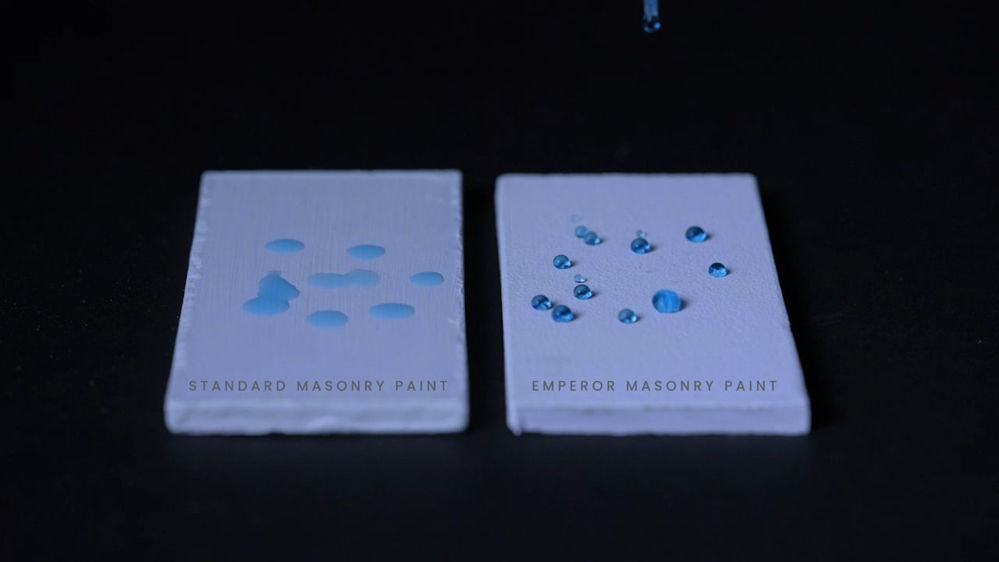
Q. CAN I APPLY A SUPER HYDROPHOBIC PAINT MYSELF?
Both Emperor Masonry Paint and Emperor Masonry Creme are quick and easy to apply, meaning anyone can make their exterior walls super hydrophobic.
Emperor Masonry Paint is applied like any other coloured paint with a brush or roller. It can be applied directly to any previously painted walls or pre-coloured silicone renders, or to bare, unpainted surfaces with the use of our Emperor Exterior Primer. Read our full guide on how to apply Emperor Masonry Paint.
Emperor Masonry Creme is a little different to a paint, but no harder to apply. It comes as a white gel that you simply lay on to brickwork in one-coat and allow to absorb into the surface. After 1-2 hours, the bricks will be completely natural but will now have super hydrophobic properties. Read our full guide on how to apply Emperor Masonry Creme.
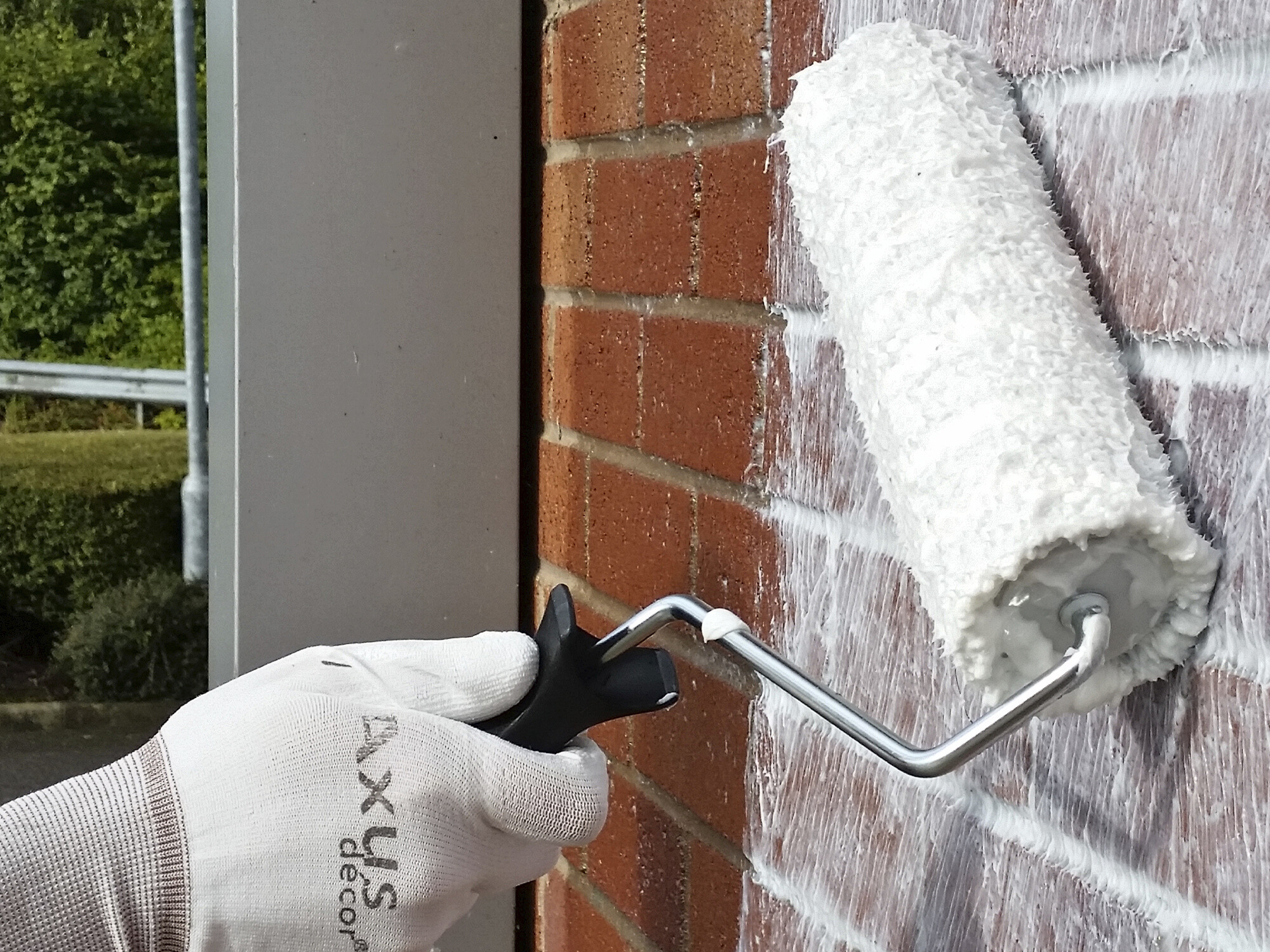
Q. ARE SAMPLES AVAILABLE?
Yes, we offer sample pots of both Emperor Masonry Creme and Emperor Masonry Paint for you to see the super hydrophobic effect for yourself.
We hope this guide has answered any questions you may have had regarding super hydrophobic paint. Want some technical advice or have a question on how Emperor super hydrophobic technology can protect your home? Contact our team of experts by calling 0161 509 9009, emailing [email protected] or by messaging us on Whatsapp.

